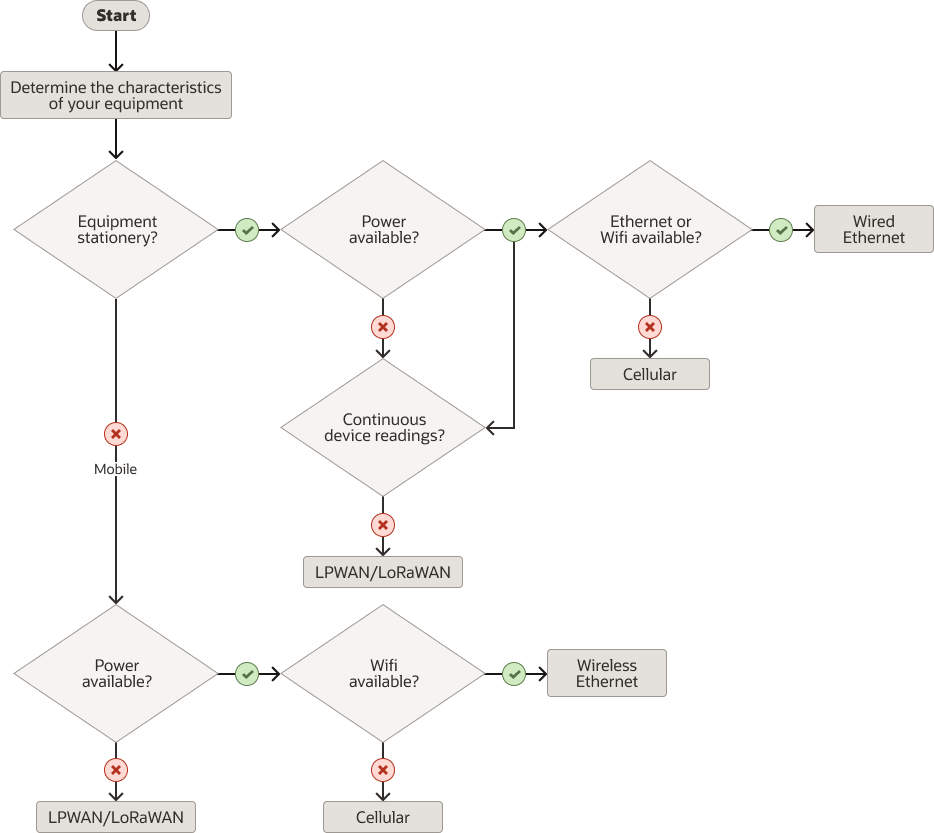Considerations for Selecting a Device Network
When considering how to connect sensor devices to your Oracle IoT applications, you'll want to start by evaluating the characteristics of your equipment to determine which network type you'll use to send device data.
Sensors measure values that are critical to the operation of your equipment such as temperature, pressure, viscosity, speed, vibration, and other physical characteristics. You can also use sensors to determine the location of your equipment by using the Global Positioning System (GPS). GPS provides the precise location of your equipment in three dimensions; longitude, latitude, and altitude. You can use GPS coordinates to locate your equipment within a structure, including the floor of the building.
After you have chosen what you want to measure, you must decide which network to use to send data from your sensors to your Oracle IoT instance. There are many network choices, and selecting the right network is determined by the type of equipment, the availability of consistent power, and the equipment location. Use this decision tree to narrow your choices.

Description of the illustration device-network-options.png
Network Stationary Equipment
For sensor devices that are associated with stationary equipment, your network options depend on the availability of power, the distance between the equipment, and the place where device data is collected. Where your equipment is located has a direct effect on the network you choose.
Examples of stationary equipment include heating, ventilation and air conditioning (HVAC) systems; industrial pumps; valves; robotic welders; and other large production systems. The location of your equipment has a direct impact on the network you choose, based on the following criteria:
- Power availability: Equipment located in a building has a continuous power source. However, equipment located in the field may be powered by batteries or renewable energy sources that don't have a continuous duty cycle, such as solar cells.
- Ethernet availability: If your equipment is in a physical structure, it's likely that you collect device data close to the equipment. In this case, devices can be wired directly to the Ethernet. When the structures are remote, or distributed, cellular services are used to send data to a central collection service.
- Data reading continuity: The amount of data that you collect from a device on your equipment depends on whether you have continuous power. When continuous power is not available, you can send data in batches, using low-power wide-area network (LPWAN), such as LoRaWAN or SigFox.
Network Mobile Equipment
For sensor devices that are associated with mobile equipment, your network options depend only on the availability of a constant power source and the availability of Wifi.
Mobile equipment does not have a fixed location, so power may not be continuous. Examples of mobile equipment include vehicles, fork lifts, hand-held meters, and most hospital equipment. The network you choose depends on the following three criteria:
- Power availability: Vehicles that transport goods (such as trucks, boats, and trains) have a stable source of power, either from the engine or from the battery used to start the motor. Hand-held devices also contain a battery, but must be charged regularly.
- Wifi availability: When your mobile equipment stays in a single location, such as a building, wireless Ethernet is a good choice to connect your devices. However, when your mobile devices are in the field, cellular services are more practical.
- Data reading continuity: When your mobile equipment doesn't have a continuous or rechargeable power source (for example, a shipping container that contains an environment measurement device), you can send data in batches, using a using low-power wide-area network (LPWAN), such as LoRaWAN or SigFox.